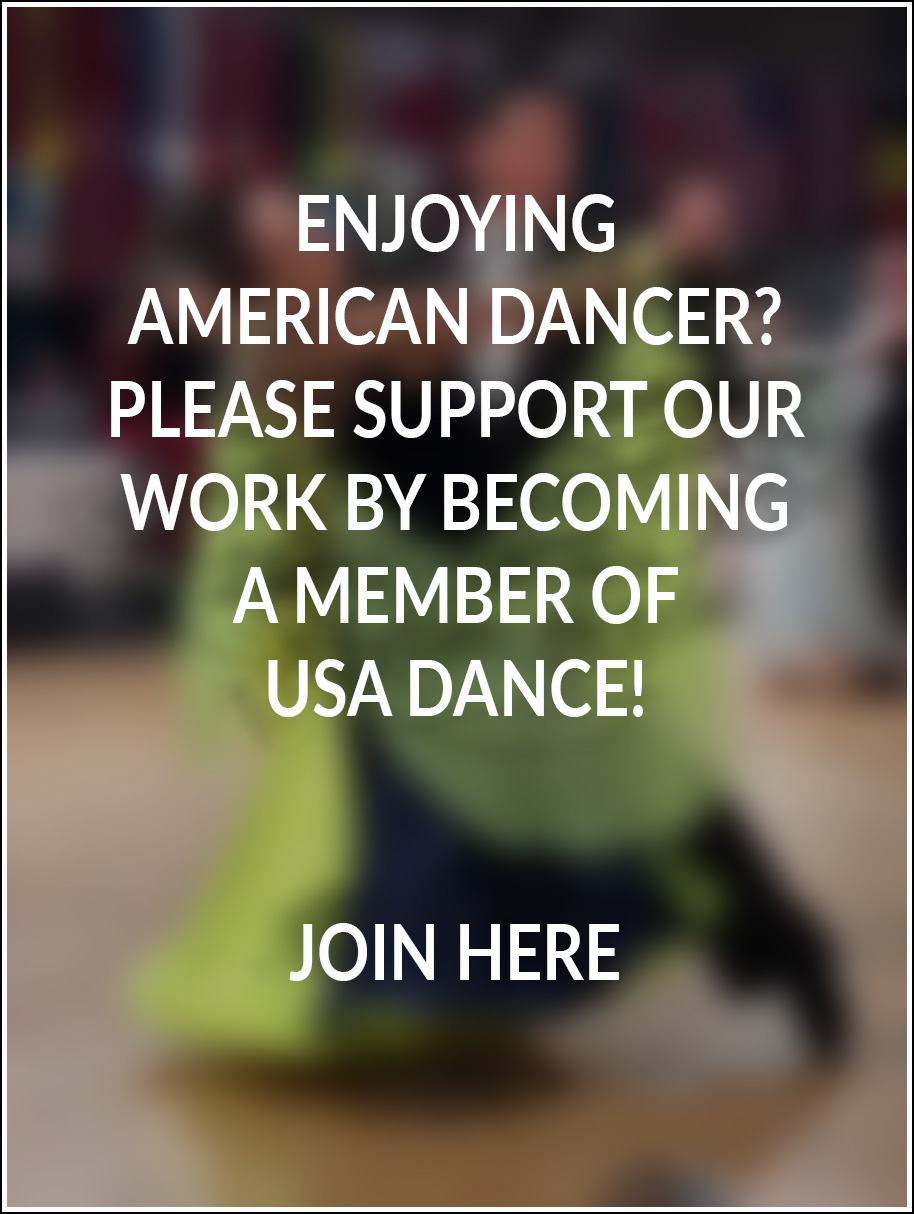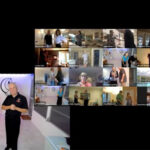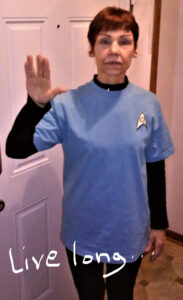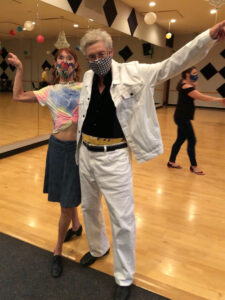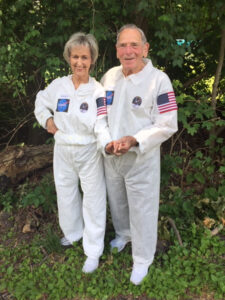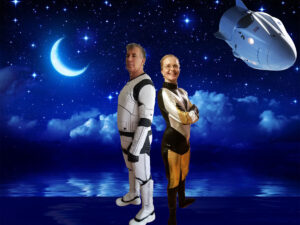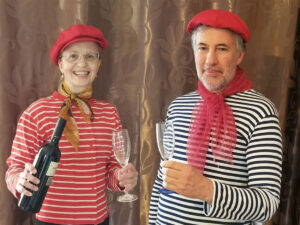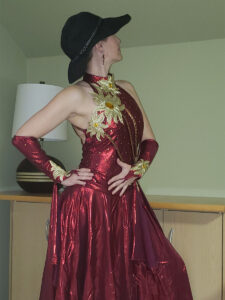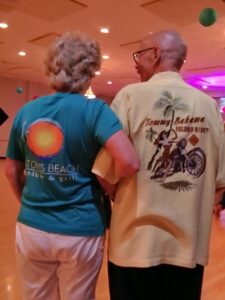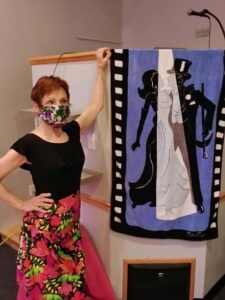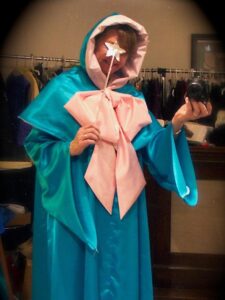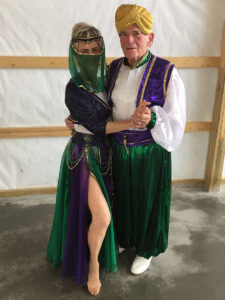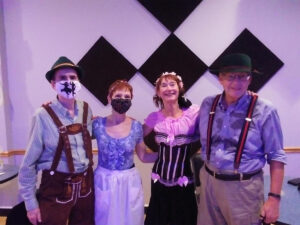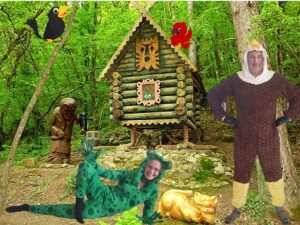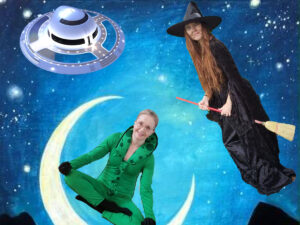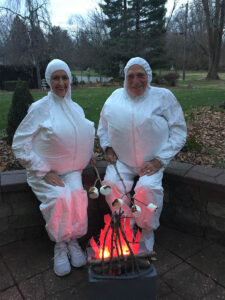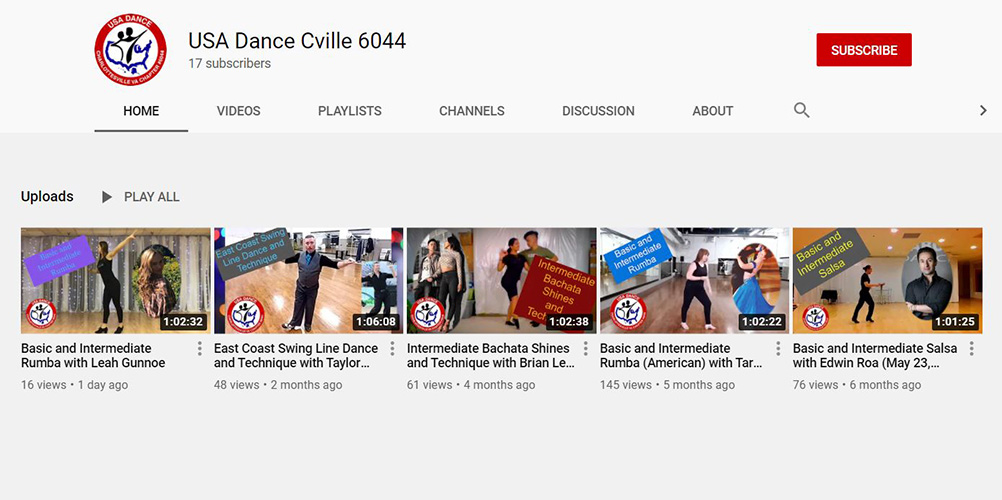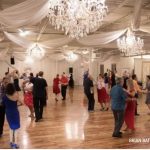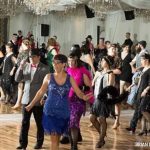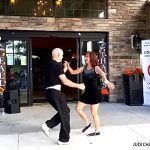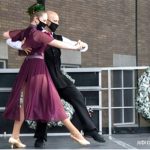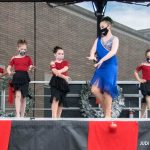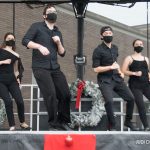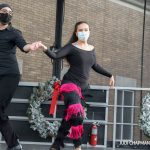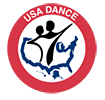COVER STORY
Social Chapters Show the Way
BY Clifford Arnold
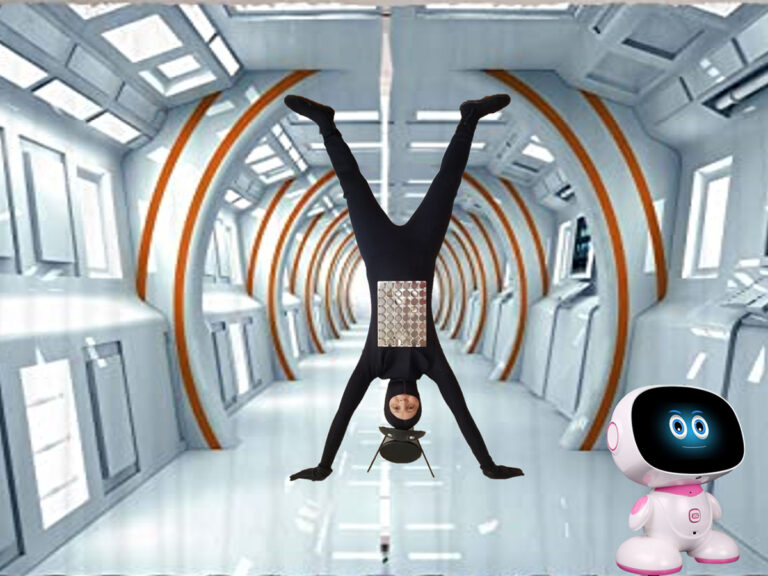
Anna Kovalyova of the Heartland Chapter in Astronauts and Aliens
“Necessity is the Mother of Invention.” In the days of Covid-19, social dancing at the monthly dances hosted by many USA Dance chapters could be a classic “super spreader” event. The risk for seniors makes the health danger quite real. Even in states that currently allow dancing events, such as Florida, South Carolina, and Indiana, social dance members are quite hesitant to dance in public, especially in indoor spaces.
American Dancer interviewed chapter leaders of seventeen USA Dance Chapters, representing 10 of the 11 districts. The goal was to get a sense of what social dancers were doing, and to collect some bright ideas for dealing with the 2020-2021 pandemic. This article presents a summary of many of those ideas, some of which may become an inspiration for other chapters. Not all involve dancing. Many support the emotional and financial health of the dance community. Overall, it is clear that USA Dance chapters recognize dancing as a community of dancers, instructors, and businesses with a shared passion. We all depend on each other.
Many USA Dance chapters are providing financial support to dance studios, instructors, and dance venues, so that these resources are not lost to the pandemic. The most popular approach for individual dancers is to prepay studios and instructors for future dance lessons. Some customers pay their teachers for lessons not taken. Some chapters make substantial food shelf donations with their reserve funds in response to local need. Chapter 6021 in Charleston SC asked its membership for funds for maintenance and upgrades to its chapter facility and received approximately $8,000. These are all examples of dancers being very generous during hard times.
A common activity is to use on-line (electronic) tools to continue some form of dancing. The first tactic is on-line “Zoom” lessons. Five of the interviewed chapters do this. The story from Charlottesville VA (Chapter 6044, see sidebar) illustrates this well, including bright ideas for supplementing payment to the instructor using tipping by PayPal and creating a YouTube channel with recordings of Zoom classes for later viewing and review. Their typical Zoom class has 20 to 45 people, and their YouTube channel has had over 500 hits since setting it up in August. Some professional instructors conduct on-line Zoom lessons. If the groups are small, the teacher provides direct feedback to individual students, much as they would in the studio. Other chapters have social-only meetings in order to provide emotional support during trying times, including a costume party held by the Heartland Chapter 2022 (Greater Indianapolis, see sidebar). These are typically smaller, four to 12 people, and some meet as often as once a week.
Of the 17 chapters interviewed, four of them have conducted indoor live dances. These occurred in the summer or fall when local regulations allowed. They all had limited numbers of dancers per event, typically between eight and 16. Chapter 6026, Daytona Beach responded to members’ requests and had a dance for 30 people on a 4,000-square-foot floor with table-seating capacity that allowed for a well-distanced crowd. The Charleston SC Chapter held their event over a two-day period to accommodate the pent-up demand for social dancing. Dancers limited themselves to a single partner or two, and masks were usually worn when not dancing. Mask wearing while dancing varies by individual.
In some cases, a single dancer hires a teacher for the evening (typically about $50/hr.) and may share the teacher with another dancer or two. This idea may have been frowned on pre-pandemic but accomplishes several things during the pandemic. It meets a real need for unmatched females and helps the instructor at a time of financial duress. Perhaps this practice may continue post-pandemic.
MASSabda, Chapter 3002 in the Greater Boston area has coupled non-profit gift giving to joining USA Dance, meeting two needs at once. They commit a $10 gift to the local food shelf for each new membership or renewal. Nor-Cal, Chapter 4004, Greater San Francisco, inspired by this idea, is donating $10 for each chapter member as of a fixed date in the future, also trying to encourage USA Dance membership.
The Orlando Chapter, 6002, has been doing outdoor dance shows for many years for local entertainment, service, and market visibility for ballroom dancing. The pandemic has not stopped this activity. In addition, they gifted significant funds to local studios, instructors, and collegiate competition awards (see sidebar story).
By far, the most common action for dancers is waiting for a vaccine. There are many stories suggesting there is a lot of pent-up demand for dancing again. Many anticipate dances will be energized and large when people feel it is safe to dance again. But this may not happen suddenly. When asked to estimate a return to normalcy for chapter dances, the estimates range from May 2021 to early 2022. This suggests that the sense of safety could range greatly from person to person and area to area.
While chapters wait for regular dancing events to return, there is an opportunity to make plans. Here are two ideas collected during the interviews:
- Plan special “return to normal” events, such as themed dances, a black-tie gala, or an evening of showcase dances and social dancing. These may improve dance attendance. With pent-up demand for dancing in 2021 or 2022, organizers might even need a larger space for such an event. These events may also inspire sponsorship donations that may cover chapter expenses for the rest of the calendar year.
- Competitions, even smaller ones, are a good way to keep or increase membership count. Simply include the USA Dance membership fee in the sign-up fee for non-members and submit their membership form for them. These new members will likely lead to more participation and energy in future social activities.
While the pandemic has significantly impacted opportunities to dance, especially social dancing, it has given dancers a strong appreciation for what they once had. When the restrictions are lifted, they will, more than ever, appreciate the human connection of moving to music together in a social environment. Hopefully, the summer of 2021 will be quite different from the summer of 2020.
Los Angeles Chapter
2020 has been a challenging year! Living in California, and more specifically living in LA County, we have undergone some of the strictest guidelines in the United States. We were forced to cancel our 16th Annual High Desert Dance Classic event one week prior to our March 2020 event.
The cancellation disappointed 500 students in grades four through 12. It took the wind out of our sails, and to this day we have not sponsored a dance event.
However, even though the world was living a nightmare, we dared to dream. We held weekly Zoom classes for the kids, for about one month after COVID-19 began, to keep the dance momentum going.
On another bright note, our chapter was the recipient of the Community Award from the Parkinson’s Foundation in June of 2020. This generous grant provided two classes for two of our cities in California. This amazing class is designed for individuals with Parkinson’s Disease and their caregivers. The best part of this program is the one-hour classes are completely FREE for one year. Our instructor is a ballroom dance professional, Lorena Bravo, who was trained in the Dance for Parkinson’s. As a result of COVID-19, we had to think out of the box and have now been providing the classes two times per week virtually on Zoom. We welcome anyone who would like to participate to attend these incredible classes. The classes are 12-1 p.m. PST Tuesdays and 10-11 a.m. PST Wednesdays. If anyone is interested in joining us or knows someone who would like to attend, please go to www.dance4yourhealth.com.
We have decided to be daring and bold, and host a one-day Virtual High Desert Dance Classic Event, all day on Saturday, March 13. We will make this FUN by giving away prizes, having high engagement with participants, offering competitions in strictly swing, cabaret, ballroom/latin, salsa, and hustle, etc. Like every year, we will have a high school division at our event, but this year, we will open the competition to ANY high school student in the country (grades nine through 12) who would like to participate.
COVID-19 may be shutting doors all over the place, but we are opening windows as quickly as we can and are daring to be different in this uncertain time.
For additional information, please contact:
Event Director – Lisa Sandoval at lisadance1@aol.com
Dance Force Director – Angie Canham at acanham723@gmail.com
Southwest Florida Chapter
As the COVID-19 pandemic came upon us and the national shut-down occurred in March, we in Southwest Florida USA Dance quickly made the decision to begin dance lessons by Zoom. Being a new endeavor for us, our instructors rose to the occasion and obtained the proper equipment to make this happen.
Because of the financial difficulties many people were facing during this time, the board decided not to charge any money, thus the lessons were free. We did, however, ask for donations as we
continued to pay our instructors. People were so generous that we continued to offer free classes all through December.
To our delight, the classes quickly became popular. This was not simply watching a video, which many other organizations offered; we could talk with our instructors and ask questions.
Additionally, the instructors would watch us and make corrections. It was as close to being live and in person as possible. Because we are in Florida, some of our attendees, who go back north for the summer (we affectionately call them “snowbirds”), were delighted they were able to continue the classes. Pretty soon we discovered others joining us from other states as well.
Eventually, we added a second class with a different instructor on a different night. Each class was unique and each one taught a different dance. Several attendees joined in both classes. We are so thrilled that we could offer these lessons to keep dancing alive and yet safe during this time of shut-down. Because we found these Zoom classes so successful, we plan to continue to offer lessons both in person and by Zoom.
Heartland Chapter
Heartland USA Dance (Chapter #2022, Indianapolis) eagerly entered the new year of 2020 with dance themes in hand and good times in mind. And its best-laid plans played out…for a couple of months. Then the virus hit, the Heartland Hiatus started, and Hoosiers hunkered down for months.
In June, following guidelines issued by the state, USA Dance, Heartland dipped its dance toes back into the water. The Chapter Board started with a small RSVP-only dance to limit attendance. It sent waivers for completion to those who responded, gathered contact information for potential tracing purposes, spaced out tables and wiped them down pre- and post-party, ensured hand sanitizers were in good supply, took temperatures at the door, and mandated mask-wearing.
Heartland continued dancing through October following all the protocols, but with an eye on rising COVID numbers, the chapter board canceled the November and December dances. Like much of the world, the club continues in a holding pattern.
Charlottesville Chapter
When COVID-19 closed studios and shut down social dancing in Virginia, our chapter moved quickly to start using Zoom to preserve our regular 4th-Saturday-of-the-month dance experience for our community of dancers.
Typically, we hold a social dance once-per-month, and we hire teachers from the area to teach a pre-dance class, one hour in duration. Of course, we could no longer do this. Cindy Gast, President of the chapter had a Zoom subscription and volunteered to hold a Zoom meetings when we would normally have held our social evenings. We continued to hire teachers to teach a class. Today, we offer this service for free to our community and to others who can join from anywhere, to continue some sense of dance normalcy and connection with each other.
We also increased the amount we pay our teachers for this class; we want them and our studios to survive through this abnormal time. Additionally, we started publicizing the teacher’s PayPal email address, and told all class attendees they can anonymously “tip” the teachers, to help support them.
Another wonderful development from this shift-change, is that one of our regular, supportive community teachers, Taylor Moore (with Charlottesville Ballroom Studio), volunteered to create and manage a YouTube channel for our chapter. We post the class videos afterwards on YouTube to further help participants review class material and allow this archived material to be available to those who may have been unable to attend the live Zoom session. Taylor also records a high-quality video of the class, edits it, and produces a professional video product for us. We make sure we receive permission ahead of time from each teacher (some have deferred), and feel this is excellent free advertising for our teachers. We include contact information for them, so students can reach out afterwards, as desired. We post both the high-quality video, as well as the Zoom recording of the class; the latter can be downloaded if desired.
Orlando Chapter
When the pandemic started, the Orlando Chapter canceled its dances and took several steps to help its members, USA Dance, and the dance community.
- The chapter sent out two rounds of relief checks to local dance instructors and studios in April and September, totaling $19,000.
- To help support the national USA Dance organization, the chapter paid annual social-dance membership fees for its 130 members.
- $400 in competitor awards were donated to the Collegiate Digital Championships that were held on-line in October and November.
- The chapter has posted a wide variety of dance videos on the chapter’s Facebook pages since March, to entertain and inspire dancers during this difficult time. Almost 250 videos have been posted since March 2020, on “Dance Movie Monday,” “Tango Tuesday,” “West Coast Swing Wednesday,” “Throwback Thursday,” “Formation Team Friday,” “Samba Saturday, and “Salsa Sunday.”
Prior to the pandemic, the Orlando chapter sponsored Special Populations programs for Alzheimers patients, disadvantaged youth, the blind, and individuals with Special Needs. Those programs are now temporarily on hold, until it is safe to resume.
But the chapter has not stopped its outdoor dance shows at arts festivals and senior facilities. The public enjoys the elegance and excitement of ballroom dancing, and it provides opportunities for dancers to show off their well-earned skills – all with the audience at a distance or safely watching from inside. Check out these hot links for examples of some recent Orlando Chapter shows:
(USA DANCE Show at Festival of Trees 2020 – YouTube); The Orlando Chapter of USA Dance show at the Orlando Art Museum’s 2020 Festival of Trees: Clips from selected numbers by dancers from Adanse’, Giving Dance, Moonlight Studio, Latin Passion, and Benny & Carol dance at the Art Museum’s 2020 Festival of Trees.
(USA DANCE Show at Orlando Fusion Fest – YouTube); The Orlando Chapter of USA Dance presented a variety of dances from different countries and cultures, for Orlando Fusion Fest. Eddie Rivera & Sophia Santiago-Burgos demonstrated Bolero (Spain), Samba (Brazil), Mambo and ChaCha (Cuba). Mark Arnott & Darla danced Rumba (Cuba) and Foxtrot (U.S.). Bobby & Judi Chapman showed Tango (Argentina) and Waltz (Austria). All dancers enjoyed a group Merengue (Dominican Republic).
(USA Dance show at Inspired Living – YouTube); The Orlando Chapter of USA Dance performed outside, for the residents and staff of Inspired Living Ocoee assisted living facility, who were seated inside. Great fun was had by all! Thanks to our dancer/volunteers Bobby & Judi Chapman; Jim & Mignon Sexton, Kenny Hicks & Linda Caplan; John & Gisela Davis. Here’s a short-clips video (doesn’t show all the dances, because the videographers did some dances too)
More information is available at their website: orlando-usadance.com
